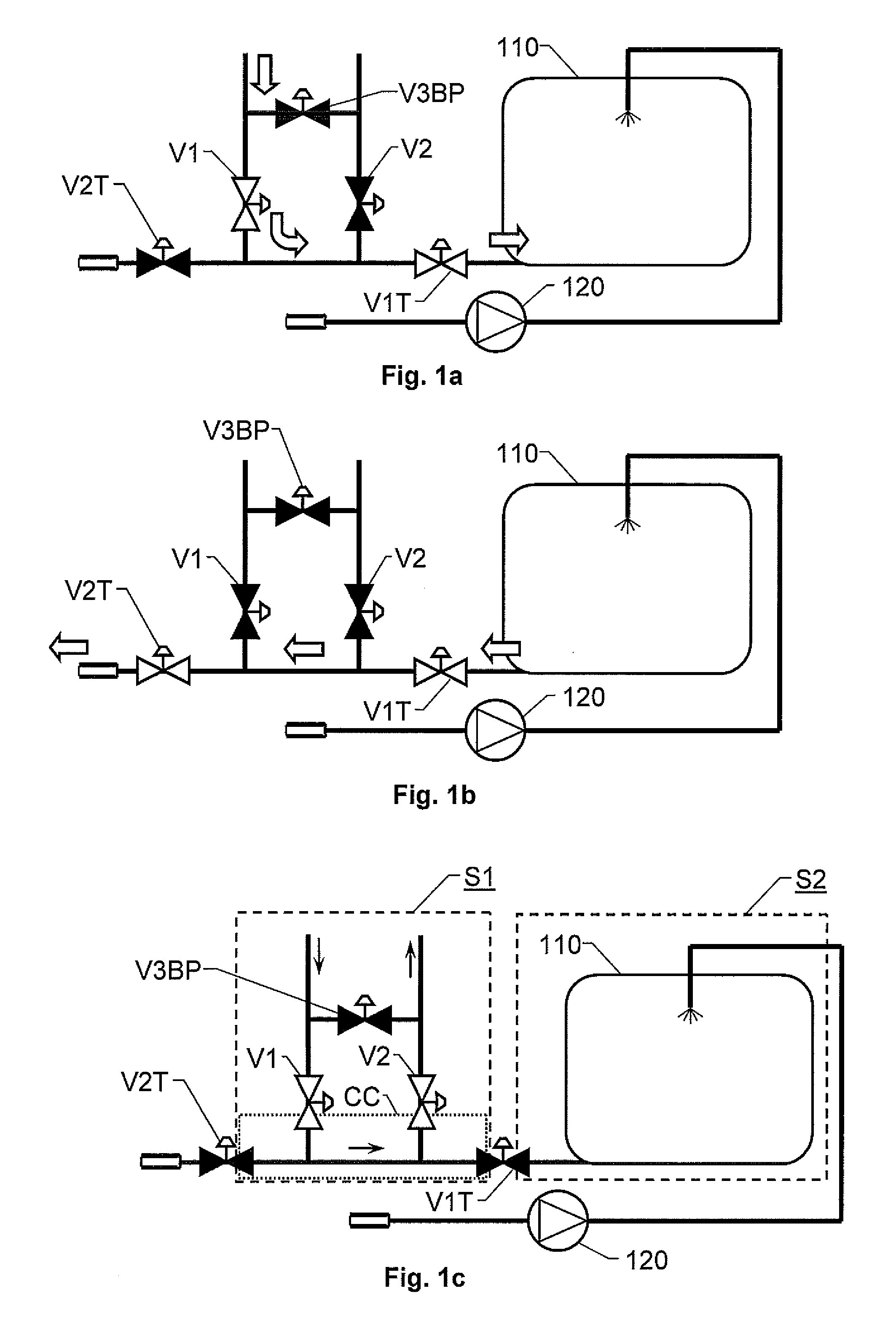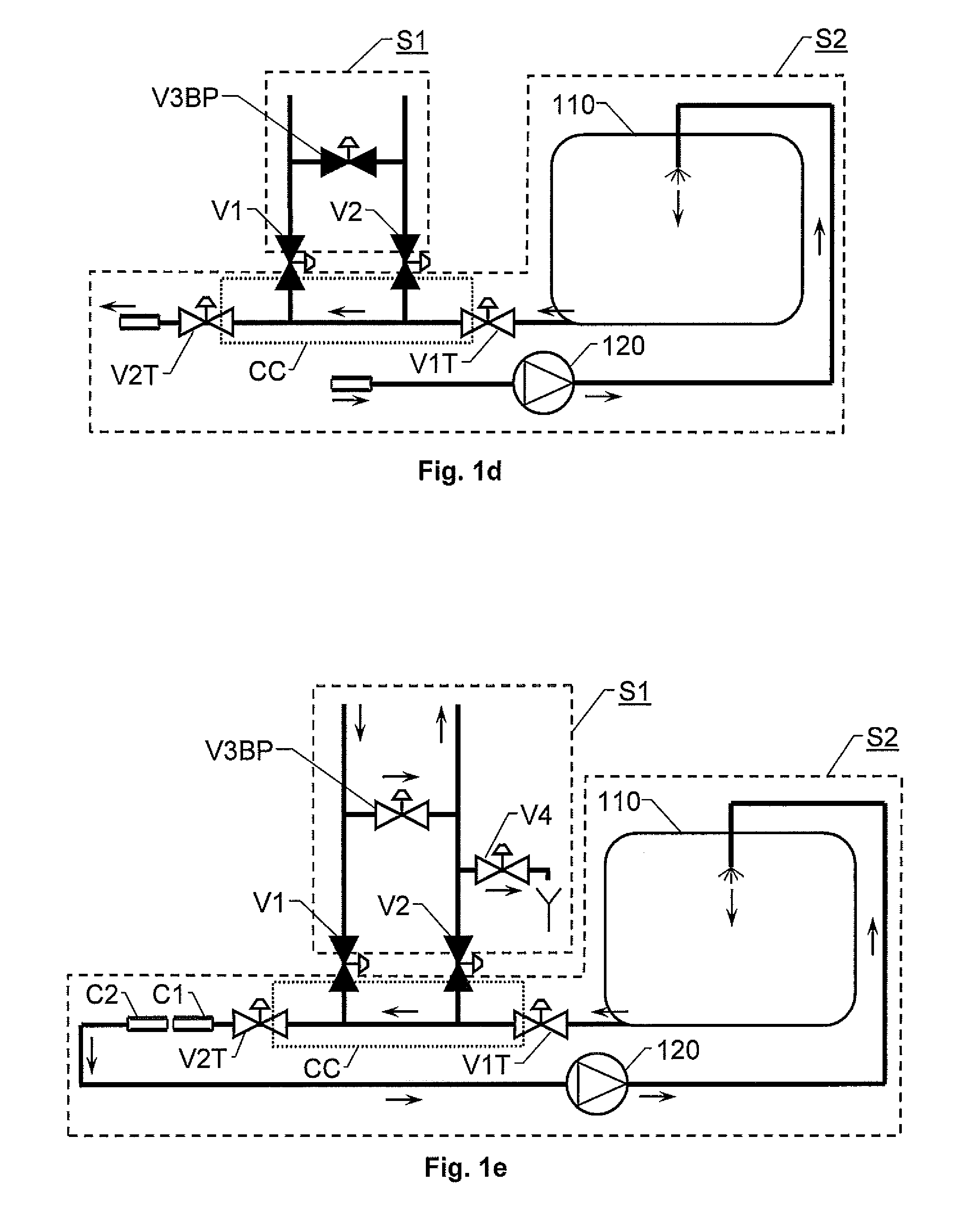Independent cleaning of interfaces between separable fluid systems
a technology of separable fluid and interface cleaning, which is applied in the direction of cleaning using liquids, cleaning processes and apparatuses, and cleaning using liquids. it can solve the problems of inability to mix the milk of healthy animals' milk with the milk and the manual cleaning of the milking robot out of operation is highly inefficient. it is reliable and flexible, and the effect of efficient cleaning
- Summary
- Abstract
- Description
- Claims
- Application Information
AI Technical Summary
Benefits of technology
Problems solved by technology
Method used
Image
Examples
first embodiment
[0024]FIG. 1a shows a schematic view over an interface between a milk extraction station (not shown) and a milk tank 110 according to the invention. Here, the milk extraction station withdraws milk from an animal and via a milk line system forwards the milk into the milk tank 110. To this aim, a first milk line valve means V1 and a first tank valve means V1T are open. To avoid recirculation of the milk into the milk line system, a second milk line valve means V2 is closed. A valve means V3BP of a by-pass arrangement is likewise closed. Further, a second tank valve means V2T towards an external connection is also closed, such that the milk is forced into the milk tank 110.
[0025]FIG. 1b shows the interface of FIG. 1a during emptying of the milk tank 110. Now, the first and second milk line valve means V1 and V2 respectively are closed, and both the first and second tank valve means V1T and V2T are open. Consequently, the milk from the tank 110 exits through the external connection wit...
second embodiment
[0035]FIG. 2a shows a schematic view over an interface between a milk extraction station and a milk tank 110 according to the invention. Here, tank valve means V1T and V3T respectively and milk line valve means V1 and V3 have interfaces towards the common cavity CC. Another tank valve means V2T is also included to provide external access to the milk tank 110.
[0036]FIG. 2a illustrates a situation when the first and second fluid systems S1 and S2 are not in fluid communication with one another, and fluid is passed through the first fluid system S1 (e.g. for cleaning purposes). To this aim, the tank valve means V1T and V3T are closed and the milk line valve means V1 and V3 are open. Consequently, the sealing surfaces of the latter valve means of the common cavity CC is accessible for through passage of fluid in the first fluid system S1. At the same time, milk can be taken out from the milk tank 110 via the tank valve means V2T.
[0037]To ensure proper cleaning of the by-pass arrangement...
third embodiment
[0040]FIG. 3a shows a schematic view over an interface between a milk extraction station and a milk tank 110 according to the invention in a situation analogous to that illustrated in FIG. 2a (i.e. when fluid is passed through the first fluid system S1). In addition to the components and units described above with reference to FIGS. 2a and 2b, the embodiment shown in FIG. 3a includes a respective shut-off arrangement associated with the valve interfaces V12, V12T and V3T towards the common cavity CC. When either of these valve interfaces is in a closed state, the shut-off arrangement is configured to trap a working fluid in a barrier cavity VB1, VB2 and VB3 respectively. The barrier cavity adjoins the valve interface in question (i.e. VB1 adjoins V12; VB2 adjoins V12T; and VB3 adjoins V3T), and the trapped working fluid has a pressure level exceeding both a first pressure level in the first fluid system S1 and a second pressure level in the second fluid system S2. To accomplish this...
PUM
 Login to View More
Login to View More Abstract
Description
Claims
Application Information
 Login to View More
Login to View More - R&D
- Intellectual Property
- Life Sciences
- Materials
- Tech Scout
- Unparalleled Data Quality
- Higher Quality Content
- 60% Fewer Hallucinations
Browse by: Latest US Patents, China's latest patents, Technical Efficacy Thesaurus, Application Domain, Technology Topic, Popular Technical Reports.
© 2025 PatSnap. All rights reserved.Legal|Privacy policy|Modern Slavery Act Transparency Statement|Sitemap|About US| Contact US: help@patsnap.com



